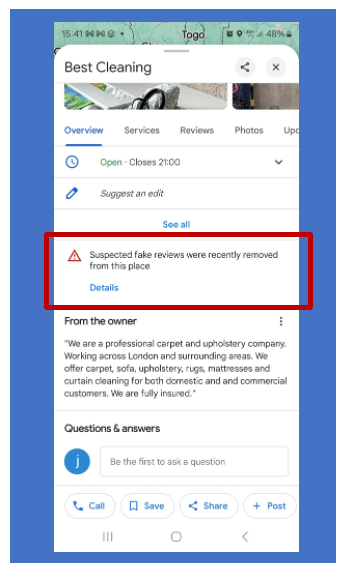Badge of Shame, Second Google Loss?, AIOs + Ads

Google Badge of Shame
Earlier this week Mike Blumenthal discovered that suspected review abuse in the UK can lead to a 30 day review ban. As a bonus it comes with a brand-killing badge of shame: "Suspected fake reviews were recently removed from this place." To our knowledge this is the first such Scarlet Letter-style public notice that Google has attached to business profiles in connection with potential review fraud. Yelp has for years put up "Consumer Alerts" (of various flavors) on business profiles when they're caught violating the rules, such as paying for reviews. Note, in the image below, it says "suspected fake reviews." That implies the algorithm has flagged the profile without human investigation. This could result in false positives but the suspension and shame badging can be can be appealed. If successful (timeframe uncertain) Google will remove the review suspension but the reputation damage might well be done by then. On the other hand, we want fraudsters to be held accountable. Regardless, it's good to see Google taking stronger action against review fraud. Even though this is the UK, it may be partly motivated by the EU's DSA, which imposes stricter content moderation requirements on large platforms.

Our take:
- What about fake review attacks? Could that get a victimized business suspended and badged as well? Unclear.
- Is this a precursor to a global rollout? That's also not clear but it's a reasonable bet that Google will also start to do this in North America.
- Months ago Google indicated and then later announced it was "unifying" LSA and GBP reviews. This was partly about fraud and partly about cost savings.
Google Headed for Another Loss?
Google is in the second week of its second major antitrust trial. As you remember, it lost the first case (about search and paid search ads) and is awaiting the judge's decision on remedies. This second case is about the Google Network and ad tech, specifically Google's suite of tools born out of its 2008 DoubleClick acquisition. The government argues (in its complaint) that Google bought DoubleClick to control both sides of digital advertising, creating a conflict of interest and unfair competition. Another argument is that Google forced publishers to use its ad server and exchange, which limited competition, stifled innovation and financially harmed advertisers and publishers. (News Corp claims to have been "held hostage" by reliance on Google ad tech.) Google is also accused of destroying potentially incriminating internal communications and abusing attorney-client privilege. In the previous trial Google was largely undone by its own witnesses' testimony and internal documents. That appears to be happening again (see, e.g., here, here, here, here), although it's still too early to predict the outcome.

Our take:
- Like the previous antitrust trial this one is before a judge. The government wanted a jury but Google maneuvered to avoid one.
- The remedies are somewhat uncertain in the first trial, though divestiture is on the table. This case offers a clear set of structural remedies.
- But Google will prevail if it can define the relevant market broadly enough to convince the judge that it faces strong competition and it's not a monopoly.
Lower Value Keywords = AIOs + Ads
SE Ranking is out with another sprawling analysis of Google AI Overviews (AIOs) that examines the relationship between Ads and AIOs in mobile and desktop results. Overall, SE Ranking found AIOs showing up more frequently in August than over the summer. On the desktop AIOs were present for 12.5% of keywords vs. just over 7% in July. That was based on automated research on roughly 100k keywords. However, on mobile it's almost the opposite: AIOs appeared 70.4% of the time according to manual research on 1,022 keywords. SE Ranking saw growth in AIO frequency in a number of verticals while others were flat. In the SE Ranking dataset, ads appeared in 13.5% of cases with an AIO on the desktop. In mobile that number was only 3.8%. The three types of ads that appeared (on the desktop) were text ads at the top of the SERP, shopping ads and text ads at the bottom of the SERP. The most frequent combination was text ads at the top and bottom of the SERP when AIOs were present. On mobile, ads and AIOs appeared most often together for shopping queries. Interestingly, on the desktop, SE Ranking found that AIOs and ads tended to appear together for lower value/CPCs and lower volume keywords. Shopping queries often triggered ads within AIOs.

Our take:
- When ads and AIOs are present on mobile there's almost zero visibility for organic search results absent scrolling (often true without AIOs).
- The fact that ads + AIOs appear for lower value, lower volume keywords may be about experimentation but also the possibility that AIOs hurt ad clicks.
- So what can we make of this? AIOs are still very much in flux as Google continues to experiment – and will be for some time.
Recent Analysis
- Near Memo episode 174: How consumers look for hotels, impact of recent EU fines on Google, possible remedies to prevent Google self-preferencing.
- Google and Booking: Symbiotic Gatekeeper Relationship in European Hotel Search, by David Mihm.
Short Takes
- How to determine if a local citation matters.
- Reddit now dominating results for "review/reviews."
- LSAs now showing you whether you've seen them before.
- Once again, how to remove negative Google reviews.
- Embarrassing: Google SMB account runs a poll about AI for SEO.
- Google Products now in top 3 mobile SERP positions 62% of the time.
- Product carousels return to AI Overviews.
- TikTok having a rough time in court, seeking to avoid "ban" (WSJ).
- The sleazy world of Reddit marketing.
- Google giving $10M to promote AI education (and Gemini).
- Stealth layoff? Amazon forcing employees back into office full time.
Listen to our latest podcast.

How can we make this better? Email us with suggestions and recommendations.

